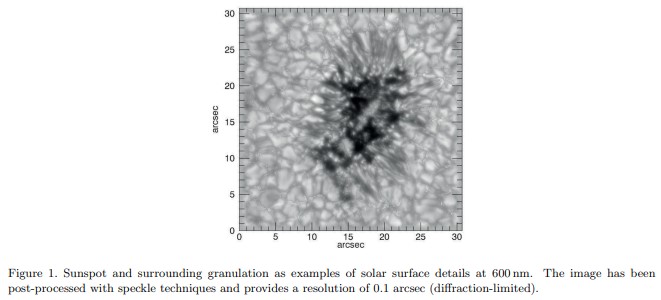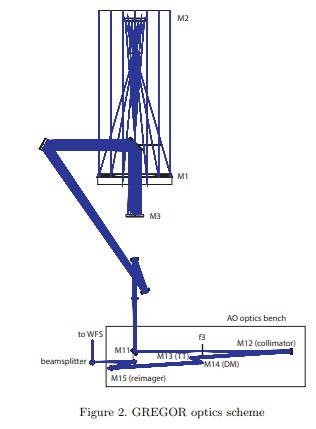The Adaptive Optics System of the 1.5m GREGOR Solar Telescope - four years of operation
ABSTRACT
We present the properties of the adaptive optics (AO) system of the German 1.5m solar telescope GREGOR, located on the island of Tenerife, Spain. The conventional AO system uses a correlating Shack-Hartmann-Sensor with a 92 mm subaperture size and a 256-actuator stacked-piezo deformable mirror (DM). AO performance results and practical experience based on the last four years of operation are presented. A recently installed second wavefront sensor with exchangeable lenslets / subaperture sizes in combination with an EM-CCD camera is used for low light observations such as polarimetric measurements of the solar system planets. Further developments include algorithmic improvements, the use of the night-time sensor for solar (off-limb) observations and solar MCAO.
1. INTRODUCTION
For many years now, Adaptive Optics has been a mature and indispensable technology at solar telescopes to conduct observations at high spatial resolution. In contrast to night-time AO systems whose point sources used as WFS targets are obviously much smaller than the isoplanatic patch, solar AO systems have to rely on correlating Shack-Hartmann sensors whose typical field of view of 10”-12” exceeds the isoplanatic patch in the visible.

Therefore solar AO systems have a bit of the characteristics of a ground layer AO in the sense that they correct a FoV that is larger than the isoplanatic patch but do not quite reach high Strehl. Due to the dependance on the C 2 n -profile, no single Strehl number for a given r0 can express the performance. Nevertheless solar AO - as night-time AO - drastically improves the image quality. Especially useful is the combination of AO and postprocessing / image reconstruction techniques such as phase diversity,1 speckle reconstruction2, 3 or MOMFBD (Multi-Object Multi Frame Blind Deconvolution)4 which benefit from the much increased signal to noise ratio (SNR) provided by the AO. The 1.5 m German solar telescope GREGOR was built to conduct solar observations at high spatial, spectral and polarimetric resolution.
 It has been equipped a with high order AO system almost from the beginning. Fig. 2 shows the optics design: GREGOR is a double Gregory-type telescope with the prime focus limiting the FoV to 150 arcsec and the downstream heat load to less than one percent of the original heat load. The secondary focus is in the rotationally symmetric part of the optics and contains a polarimetric calibration unit. The tertiary mirror M3 generates the final f/40 beam. M11, being close to the focus, is used to center the pupil on the DM by utilizing the intensity information of the WFS’ edge subapertures. The AO setup itself is a typical AO relay consisting of collimator, tip-tilt mirror, DM and reimager. The WFS pickoff is close the science focus, keeping the non-common path aberrations (NCPA) low.
It has been equipped a with high order AO system almost from the beginning. Fig. 2 shows the optics design: GREGOR is a double Gregory-type telescope with the prime focus limiting the FoV to 150 arcsec and the downstream heat load to less than one percent of the original heat load. The secondary focus is in the rotationally symmetric part of the optics and contains a polarimetric calibration unit. The tertiary mirror M3 generates the final f/40 beam. M11, being close to the focus, is used to center the pupil on the DM by utilizing the intensity information of the WFS’ edge subapertures. The AO setup itself is a typical AO relay consisting of collimator, tip-tilt mirror, DM and reimager. The WFS pickoff is close the science focus, keeping the non-common path aberrations (NCPA) low.
Для продолжения чтения вы можете скачать полную версию материала по ссылке ниже